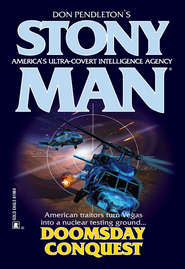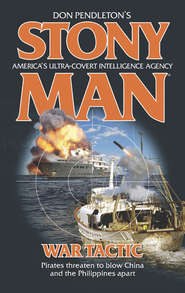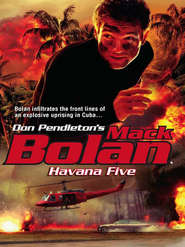По всем вопросам обращайтесь на: info@litportal.ru
(©) 2003-2024.
✖
Sky Sentinels
Автор
Год написания книги
2019
Настройки чтения
Размер шрифта
Высота строк
Поля
Langford held up his hand and shook his head to the uniformed men. They lowered their weapons.
“Somebody you know?” Lyons said.
“Oh, yeah.” The OSBI director grinned. “Retired agent. And I’d forgotten he went to this church.” He paused a moment, then said, “Carl Lyons, meet Gary Hooks. Former agent and close-quarters-combat expert with and without weapons.”
The two men shook hands.
“You’re a little late for the service, Gary,” Langford said.
“We always are,” Hooks said. “My wife can’t stand that canned music they play on Sunday mornings. So we get here just in time for the sermon and sneak into a back pew.” He looked around for a moment, taking in all of the other officers, weapons and equipment. “Then again, maybe God made me late on purpose,” he said. “My guess is none of you know jack about the layout inside of the church.”
“No details or schematics,” Langford said.
“It’s fairly simple,” Hooks said, tightening the turquoise bolo around his neck. “Right behind those front doors is a foyer that is about ten feet wide and circles the sanctuary. But it’s a killing ground. They—whoever they are—could stand just inside the sanctuary itself, with the doors propped back, and kill every one of us who opened one of the outside doors before we even got inside.”
“Any other ways in?” Blancanales asked Hooks. “Ways these guys wouldn’t know?”
“Well,” Hooks said, squinting slightly, “this isn’t ancient Rome and we don’t have any catacombs to hide in. But there’s a way in they may not have thought about, particularly since they’re Muslims and particularly since this is a Baptist church.” He looked up at the roof of the large building. “There’s one way in I think enough of us could use to get the drop on them. That’d give the rest of these guys time to come through the doors,” he said, then cleared his throat. “Your team, Lyons, plus Langford and me. Our job will be to take out the sentries at the sanctuary doors from behind so the SWAT teams and other officers can come in and join us.”
“And just how do you plan to get behind them, Gary?” Langford asked,
Hooks grinned. “Since you’re a Methodist, I wouldn’t expect you to know,” he said.
Langford laughed, and it was obvious to Lyons that this was an old joke between the two old friends. “Don’t worry,” Hooks said. “I’ll show you all the way. But we’ve got to spot and disarm whatever explosives they’ve set up, too. And that could get tricky.” He paused a second and cleared his throat. “You know what this is, Dwayne,” he said, using Langford’s first name. “One giant suicide bombing. Those men inside plan to blow themselves up along with everyone else, and you know it. I know that because they haven’t paid a bit of attention to what we’re doing outside here. Has anyone so much as seen a face in any of those windows?”
Langford shook his head. “But you’re retired, Gary,” he said. “You don’t have to—”
“I’m not retired when somebody tries to blow up my church,” Hooks said. He glanced around. “You’ve got some good men out here,” he added finally. “I know, because I trained most of them in close-quarters combat. But none of them know the inside of that church like I do.”
Langford laughed softly again, then looked at Lyons. “He never was worth a damn at taking orders,” he said.
“I think what he’s saying makes sense,” Lyons said. “We need Hooks to come with us.”
“Then let’s get on with it,” Gary Hooks said.
“I know this is a foolish question, Gary,” Langford said. “But do you have a gun on you?”
“One or two,” said Hooks. “But I need one more.” He turned swiftly and returned to his pickup, kissed his wife, and came back carrying a worn canvas briefcase. A moment later he produced a 5.56 mm Kel-Tec PLR-16 pistol and began stuffing extra loaded magazines into the pockets of his gray suit.
As soon as he returned, Langford turned to a man at his side. “Give me your AR, Don,” he said.
As he grabbed the AR-15 from his subordinate’s hands he said, “Everybody ready?”
Lyons nodded. “Then let’s go. You know the layout,” he said, looking to Hooks, “so you lead the way.”
A second later they were following the man in the gray suit and turquoise bolo tie around the building to the side of the church.
T HE RECENTLY PURCHASED Pizza Hut building was not the only addition the Southern Hills Baptist church had planned. A vacant lot where an old crumbling wood-frame house had been torn down stood adjacent to the church’s gymnasium, and the workmen who were building new Sunday-school classrooms had left several ladders at the site.
While Blancanales stood watch through the windows into the gym to make sure no curious eyes were on them, Lyons, Schwarz, Hooks and Langford hefted the tallest of the ladders and hauled it to the side of the church.
“See anything?” Lyons asked when they had the ladder resting against the brick.
“Nothing but basketball goals and foul lines,” Blancanales said.
Lyons led the way as the other men steadied the ladder, then turned and assisted each of the other men up onto the asphalt roof of the church.
The men made their way as quietly as possible across the top of the building. When they reached an airshaft roughly halfway toward the front of the church, Hooks stopped. “This leads down into the dressing rooms behind the baptistry,” he said. “From there we can step down into the water itself. There’s a curtain that’ll cover us from sight.”
Lyons nodded. It was at this point, he knew, that the leadership of the quickly formed five-man team should return to him. Hooks looked him squarely in the eyes and nodded his acknowledgment.
“Okay, guys,” the former LAPD detective said. “I’ll go first. None of us hit the water until we’re all down. Got it?”
Four heads nodded back at him.
With Hooks’s and Langford’s help, Lyons pried the metal shaft off the hole leading down into the building. His Randall Model 1 fighting knife took care of the screen, and then he lowered himself through the passageway to the tile floor. His boots tapped as they hit the floor and he heard the curtain in front of the water start to move.
Someone had heard him.
And there was absolutely no place to hide.
Ignoring his own order of a moment earlier, Lyons lowered himself into the water of the baptistry and ducked his head beneath the surface, pressing himself as tightly as he could against the wall directly beneath the curtain. Through the water, he could see the curtain move. A bearded man wearing a red scarf with his khaki fatigues and BDU cap peered through the open window.
But he didn’t look down. And a moment later, the curtain closed again.
Lyons rose slowly through the water, acutely aware of the unavoidable sound he was making. But it was evidently not as loud as his drop had been because the curtain remained closed. Climbing up the two steps and back onto the tile floor, he looked upward and motioned for the next man to come down. Lyons caught Schwarz’s legs before they hit the floor, then lowered him silently.
Together the two Able Team operatives did the same for the remaining three men.
Holding a finger to his lips, Lyons then gave hand signals to direct the other men down into the water. He remembered the red scarf the terrorist had worn as he looked through the curtain a minute earlier, and frowned.
These terrorists had claimed to be legitimate Iranian troops. And the red scarf was official issue to the Revolutionary Guard—like the green beret to U.S. Special Forces.
The president of Iran was crazy—few people would argue that point. But was he crazy enough to actually send official troops inside America’s borders and attack a house of worship? Of course anyone could buy a red scarf and tie it around his neck and call himself anything from Revolutionary Guard to Gene Autry if he wanted to. The terrorists could easily be al-Qaeda or Hezbollah or Hamas or some other group simply masquerading as Pasdaran troops.
At this point it didn’t matter. He and the rest of his men could sort that all out after the thousand or so hostages on the other side of the curtain were safe.
Lyons’s M-16 was already soaked with water from his earlier dip beneath the curtain. But that mattered little with modern firearms. It would still fire. So holding it in front of him, he moved slowly to the corner of the curtain and used the barrel to push it slightly to the side.
Directly through the window was a large choir loft, with terrified men and women dressed in robes still sitting in their chairs. Mixed in with them were more men in khaki uniforms and red scarves.
One of them had to be the man who had almost spotted him earlier.
Behind the pulpit, and making full use of the microphone in front of him, another terrorist dressed in identical fatigues and a red scarf stood spouting Islamic terrorist propaganda in broken English. Lyons could hear him demanding that the congregation all convert to Islam immediately or be killed and go directly to Hell.
Other men with AK-47s, Uzis and a variety of other weaponry stood next to the speaker. Still more patrolled the aisles, and in the balcony Lyons could see that the same thing was going on. These men in red scarves—perhaps Iranian Pasdarans, perhaps simple terrorists in disguise—were covering their hostages from every angle.
What interested Carl Lyons most, however, was a red-scarfed man on the stage sitting next to a Caucasian in a blue suit. Lyons suspected the man in the suit was the minister. In his midforties, he had slightly graying hair. He sat quietly. But his face showed no fear. If anything, what emanated from the pastor was confidence and determination.











